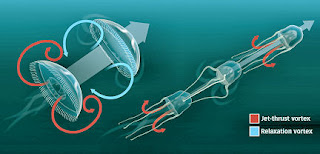I've read where supposedly "Jellyfish Don't Swim" - because they can be moved so much by the currents. But I would call their movements swimming.
...But jet propulsion is actually older than the Flintstones. It's a standard means of locomotion for jellyfish, the earliest animals to swim the seas using muscles. Jellies have been jet-propelling for at least 550 million years, yet only recently have scientists begun to understand how the challenges of moving in fluid have shaped jellyfish evolution.Cladonema_pacifica
This Scyphozoan jellyfish, with its UFO-shaped bell, moves to a slower rhythm than its smaller, rocket-shaped relatives. New studies link jellyfish means of locomotion to body size and shape.
Jellyfish invented muscle-powered movement, a feat that allowed them to diversify into a number of ecological nooks and crannies. But jelly muscles are relatively meager and the jet-pack method of motion requires serious strength. That has presented a mystery about how some species of jellyfish can get so big. New studies have begun to explain how enormous gelatinous creatures muster the strength to swim. The answers may lead to novel designs for underwater vehicles and are prompting scientists to rethink how to harness energy from wind currents...
...the research team filmed some broad, UFO-shaped jellies known as moon jellyfish, or Aurelia aurita, in shallow waters of the Adriatic Sea and in a saltwater lake on the Adriatic island of Mljet. Again, the scientists used dye to visualize the animals' wakes. The researchers immediately noticed that these jellies didn't zip to and fro, but meandered, using a leisurely half-jet, half-paddle approach. Like their rocket-shaped relatives, these broader, flatter jellies moved by contracting their meager muscles, squeezing water from their bells into a swirling vortex behind them. But when a moon jellyfish relaxed, postsqueeze, and water rushed in to refill its bell, the dye revealed a second vortex forming at the bell's edge. Dabiri realized that this second vortex was swirling in the opposite direction of that of the first, like water swirling inward at the edge of a bowl pushed down into a basin of water. The collision of these opposing, swirling masses of water was providing enough thrust to propel the moon jellyfish forward...
Dabiri crunched the numbers again, incorporating bell dimensions and the force of the second vortex into his equations. His new model, published with Colin and Costello in the June 2007 Journal of Experimental Biology, suggests that broad jellies, no matter how big, should be able to generate enough force to swim, albeit via a gentle, slow paddle, not a jet. And because of the superior elasticity of a jelly's gooey cellular matrix, the critter doesn't use extra energy to generate the second vortex. It's like a spring that's been compressed and wants to recoil, says Dabiri. "The relaxation phase is essentially for free."
Dabiri is impressed by the fancy footwork of these broad jellies and by how they've managed with the hand (or tentacles) that they've been dealt...
Young jellies are also limited in terms of purposeful movement. They begin life as small larvae dispersed by currents and eventually settle on the bottom of the sea. The majority then grow into polyps, small finger- or pear-shaped lumps. Some species have polyps that can crawl around a bit, but mostly they stay put, waiting for something tasty to stumble into their tentacles. This was life in the 'burbs for Cnidarians, until the day, roughly 550 million years ago, that a polyp ancestor of today's jellies grew a little bud that broke off and got into the swim of things. Called medusans, these free jellies are the adult jellyfish that marinelife fans know and love (or fear). Almost all of today's jellies still begin as larvae, become polyps, and eventually medusans, free to roam the seas.
It's likely that the first free-floating jellies were the only swimmers in the ancient seas, says Collins. There would have been algae and coral larvae and such floating around, and eventually ancient versions of lobsters and other marine arthropods. But the highways were basically clear. No sharks. No fish. Certainly no people. The jellies had the pool to themselves...
Of course, jellies may have done it first, but most animals have since figured out how to generate force by contracting muscles, points out Edwin DeMont of St. Francis Xavier University in Antigonish, Nova Scotia. But many creatures use two muscles where jellies use one. Human biceps and triceps, for example, pair up so that when one contracts, the other pulls back to rest. The equivalent in jellies is the springy, postsqueeze expansion of their goo...

1 comment:
Good readingg this post
Post a Comment